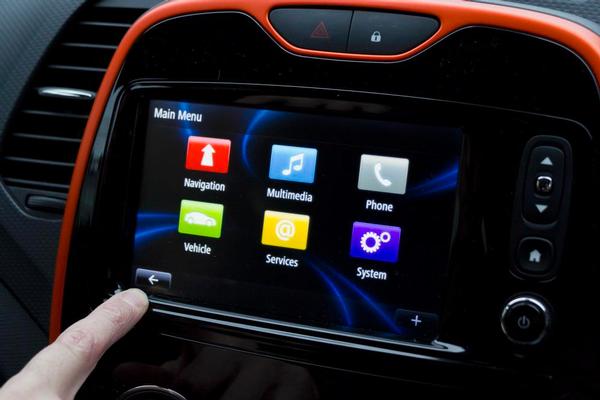Table of Contents
ToggleThis blog post and its associated images have been reproduced with the explicit permission of TkXel , MarkiTech’s technology partner.
Written by,
Umair Maqsood, Heads Marketing,
As mobile ecosystems mature, more and more opportunities are becoming available for mobile app development in the automobile industry. Connected cars are a reality and third-party software developers are enhancing the in-vehicle user experience (UX) by injecting their apps into the modern, Internet connected dashboards. In-Vehicle infotainment services include navigation, news, music and entertainment, healthcare and much more, offering a fully connected experience for consumers.
Chances are that your current entertainment systems are about to become redundant. Many cars come with a pre-loaded GPS, and boast shiny, flashy touchscreens. There’s nothing wrong with them practically, technically or aesthetically, but cars just don’t allow much room for over the air (OTA) upgrades and I have never seen a mechanic updating the software on my car.
Some might suggest installing tablets and smartphones on vehicle dashboards to overcome any challenges, but that wouldn’t work at all. It’s like taking a bumpy ride downhill when you’re told it will be a stroll in the park. The environment in a car is highly unfavorable for consumer gizmos, which have to cope with a lot of issues, such as:
- Varying high and low temperatures
- Humidity, dust and water splashes
- Constant vibrations and occasional bumps
Hence, consumer tech is not finding a slot on smart car dashboards. In-Vehicle infotainment systems are able to endure more and last longer.
Infotainment platforms are technologically advanced and smarter. Apple and Google are the front-runners in this domain, having rolled out Apple CarPlay and Android Auto respectively. There are several others exploring this niche, such as NVIDIA, Texas Motors and GM Motors.
These platforms offer a major shift from the traditional infotainment systems and incorporate the latest technologies to upgrade and advance the in-car experiences.
Punchkick strategist Billy Collins argues, “Today’s connected car platforms aren’t an extension of the phone or the tablet. They’re completely different screens with their own unique use cases.”
So, what potential do these platforms hold for developers?
Most people are under the impression that third-party development for these platforms will be limited because of safety considerations and an altogether different experience (driving). They also feel that the market growth will be stunted for several years due to prolonged product cycles.
While cell phones become redundant in a couple of years, cars are manufactured to stay on the road for at least a decade. This means that the infotainment user-base is bound to increase even if the overall sales are low. According to one report, by 2019, about 24 million new cars will have Apple CarPlay installed. The research also suggests that Android Auto will be close behind Apple’s CarPlay.
It’s not actually about the quantity of advanced infotainment systems in vehicles, but about the quality.
Developers need to keep one very important thing in mind that “this is not mobile but automobile” and anything being projected on screens has to be “very relevant”. The screens are not mere projections of mobile and thus standard mobile apps such as news readers, social apps, outdoor and fitness app, or games, make no sense at all in a car. Apps should be developed “particularly for in-vehicle infotainment” purposes.
In-Vehicle infotainment systems provide an opportunity for developers to come up with a next “killer app” that is raved for its usefulness and originality. Before developing, consider all aspects of driving and keep them in mind when working. This will give you a clear perspective and help you engineer your app to perfection. Here’s what most of us like doing while driving:
- Music and Radio
- Voice calling and speech-to-text conversion
- Navigation and Maps
- Voice Control features
- Relevant notifications
Most of these domains will already be covered as core apps pre-loaded on the infotainment systems, leaving little room for developers to maneuver. But this also means that there is ample space for genius and originality.
Developers do face obvious problems, especially to generate revenue from these apps. There can be no ads on these dashboards, as they would put drivers at risk. Even if the developers were able to push through safe ads, the small user base and low usage frequency will mean that the revenue generated will be insufficient to sustain the apps.
Still, developers know how to weave magic and they will come up with something worth noticing. They are explorers, continuously trying to think of something big within a domain. Here are a few more domains which could be explored to accomplish new feats:
- Fuel economy and efficiency
- Health and personal efficiency
- Security
- Road safety
- Insurance liability
Developers could focus themselves on traveler and safety, depending on how refined an infotainment system is. Developers, for example, can gather information on a road’s average vehicle speed and road conditions, and gather cellular data to guess the amount of traffic on a particular road.
Developers can also help to eliminate one major concern for most commuters — theft! Put up some IP cameras and you can learn who tried to break into your car.
Besides this, fuel economy can be improved through smart technological solutions. Apps can suggest the most favorable routes, as well as track your trips and teach you driving lessons.
Similarly, healthcare apps can prevent drivers from major and fatal accidents. They can suggest taking a break when they sense you are stressed. Such apps can also observe your behavior and posture through cams and can alert you if you appear to be sleeping.
Developing for Android Auto and Apple CarPlay
So if you finally feel that you can develop for automobiles, start doing it instead of wasting your time.
Android Auto has a lot of resources that can be used by developers while building apps for in-vehicle infotainment services. The focus should be on getting apps to improve the driving experiences by blending technology with aesthetics, etc.
There are fewer free resources available on Apple’s CarPlay, but we would bet they are good quality.
The two major platforms are still evolving, so we expect a lot more repositories in the future.
What is important for developers is to note that these products are meant to stay in the market for a long time, and consumers will have less options to upgrade and improve what they initially purchased. There are limitations to these platforms, especially the probability of having only a single platform installed, without the option of switching to another (Auto to CarPlay, etc.). This might affect the user experience in the long run and can also affect the resale value of the vehicle.
So developers need to give their best shot at developing applications that can keep users engaged, informed and efficient in the long run. It would be a plus for developers if the makers of these platforms come up with ways to keep apps updated, otherwise, developers must fill their apps with loads of information that will remain verifiable over time.


